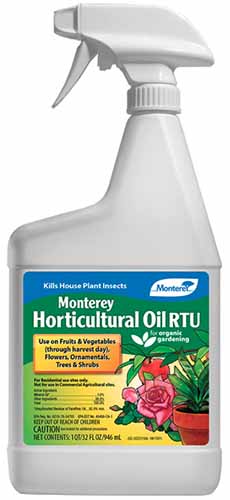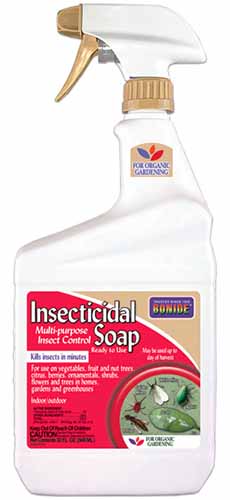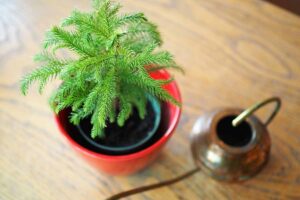Chamaedorea seifrizii
Can’t decide on whether to grow bamboo or a palm? Split the difference with the bamboo palm, which rocks the appearance of both!
With elegant, arching fronds and narrow clumps of bamboo-like stems, Chamaedorea seifrizii is the perfect palm for gracing your indoor spaces.
With low maintenance requirements, plus a tolerance for low light and underwatering, the bamboo palm is easy to care for and hard to kill.
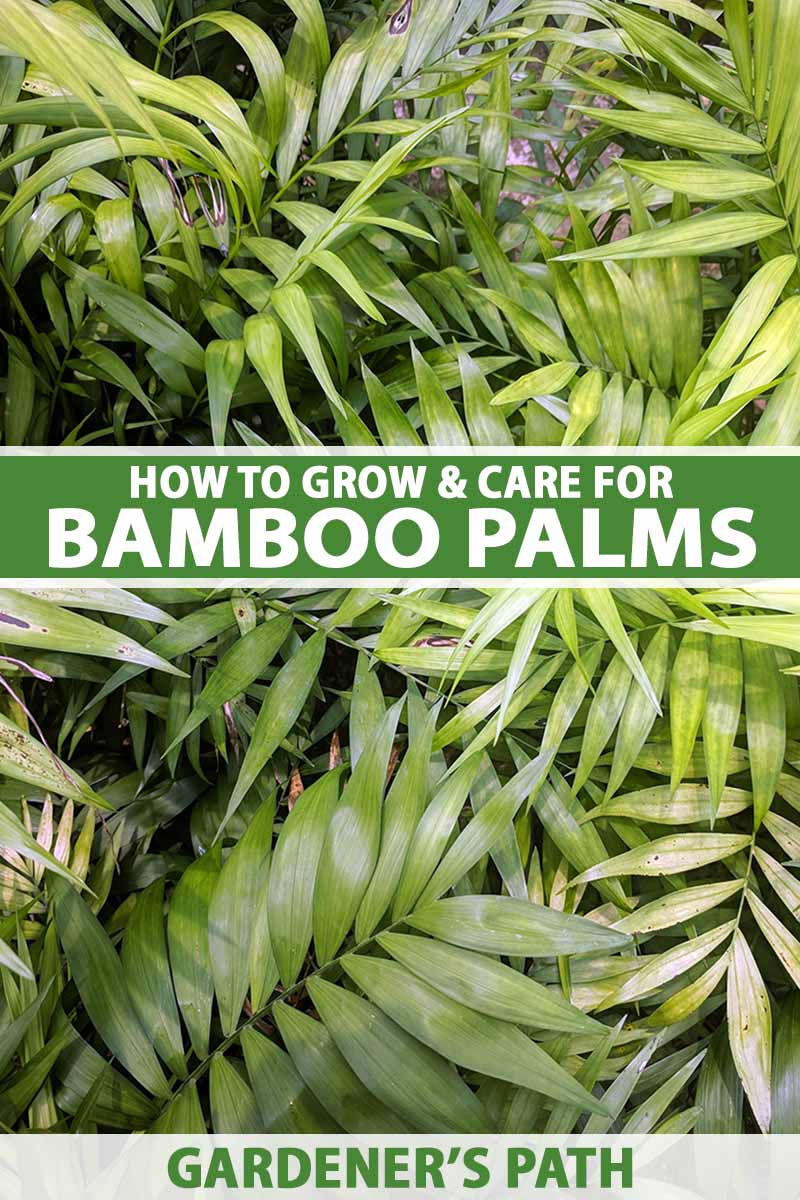
We link to vendors to help you find relevant products. If you buy from one of our links, we may earn a commission.
That being said, an optimally cultivated bamboo palm looks way better than one that’s given the bare minimum of care.
So what does optimal cultivation for bamboo palms look like, exactly? I’m glad you asked.
In this guide, we’ll go over what you need to do to keep your bamboo palm thriving. From propagation to growing requirements to health care tips, no stone will be left unturned.
Here are the details of what I’ll cover:
What You’ll Learn
What Are Bamboo Palms?
Belonging to the Arecaceae family of true palm plants, Chamaedorea seifrizii is a flowering evergreen perennial that hails from southeast Mexico and the Central American countries of Belize, Guatemala, and Honduras.
Hardy in USDA Zones 10 to 11, the bamboo palm can either be grown outdoors full-time in adequately warm areas or predominantly indoors as a houseplant in cooler climates.
Regardless of location, it brings with it a beautiful tropical aesthetic that never fails to amaze.
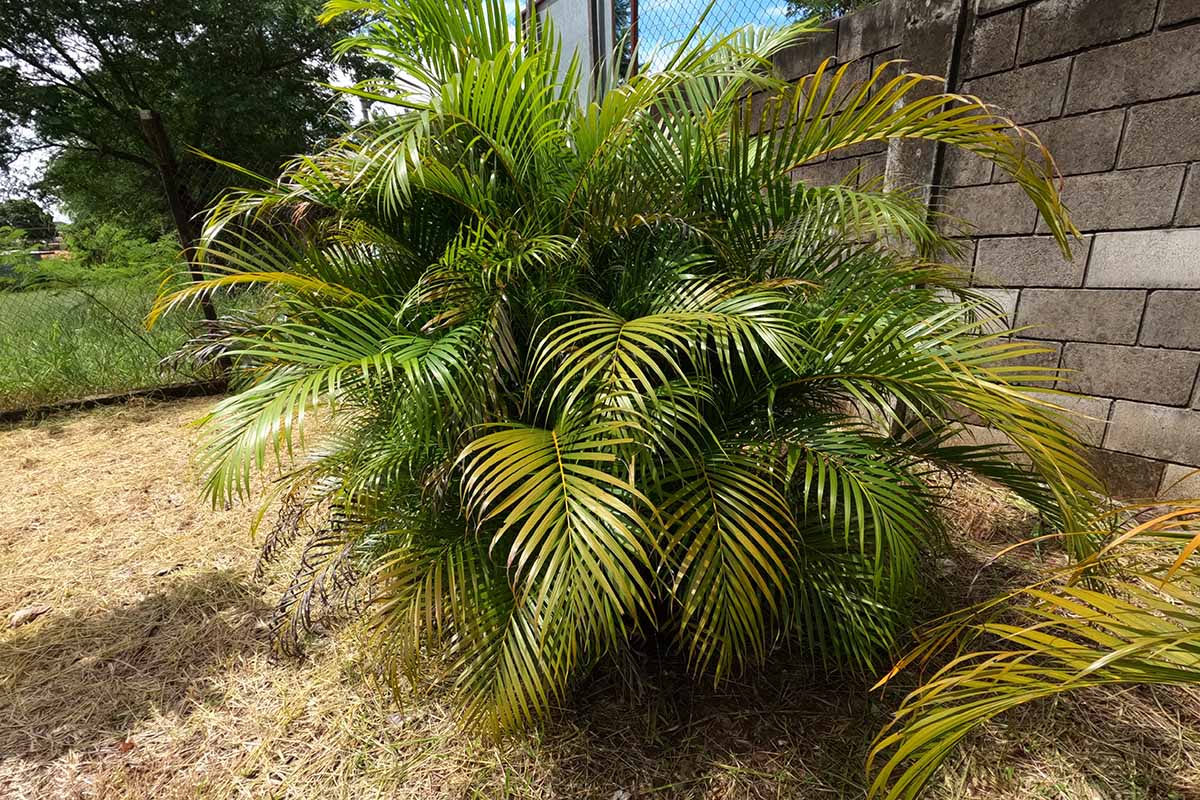
In a boundless outdoor environment, a single bamboo palm can grow three to 10 feet tall and three to six feet wide.
However, potted-up specimens grown indoors tend to max out at much smaller dimensions, thankfully.
From 18- to 24-inch fronds grow thin, deep green, lance-shaped leaflets, each about eight inches long and one inch wide.
In summer to fall, four- to six-inch green flower stalks bearing dioecious yellow blooms grow from the bases of old leaves – although this probably won’t happen when the plant is grown indoors.
If pollinated by a male plant, the flower stalks of female bamboo palms turn bright orange while the fruits change from green to a dark bluish-black.
Be careful, though: the fruits can irritate your skin if you handle them without gloves. But hey, at least they’re attractive to birds!
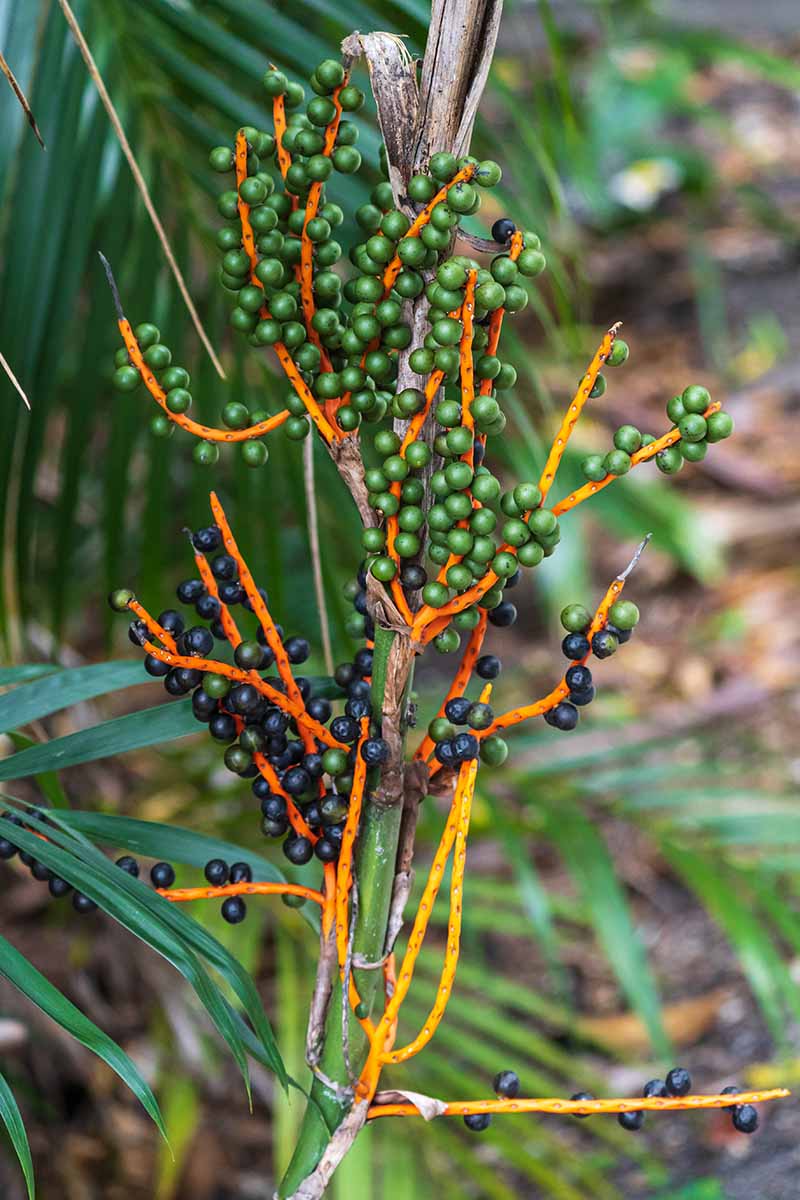
All of these structures grow from tall, skinny stems, which either shoot straight up or are angled to the side. With their bamboo-like appearance, leaf nodes, and ability to spread via suckering offshoots, it’s easy to see where the “bamboo” moniker comes from.
C. seifrizii has been introduced into Florida and Singapore, along with select islands of French Polynesia, Hawaii, and New Caledonia.
In Florida specifically, it is listed as a Category II invasive by the Florida Exotic Pest Plant Council, meaning that, according to the Florida Invasive Species Council, they “have increased in abundance or frequency but have not yet altered Florida plant communities to the extent shown by Category I species.”
A vigorous outdoor growth rate… how bamboo-like. But if you put C. seifrizii in a pot and keep it indoors, then you should have a reduced growth rate. Put it in the right spot, and you won’t even have to give it that much attention… unless you want to, of course.
Bamboo Palm Propagation
For an ornamental like the bamboo palm, I wouldn’t recommend growing it from seed, at least not if you’re a beginner.
C. seifrizii seeds can take up to six months to germinate, the fruits that they’re housed in can cause contact dermatitis, and fruiting is unlikely to happen in the case of indoor plants.
Bamboo palm propagation is best done via division or by transplanting a purchased nursery start.
Division
Bamboo palm spreads via offshoots – stems that pop up at the edges of the plant’s crown – if you separate one of these from the mother plant, it can be planted and grown all on its own.
In spring, lift your plant from its container or planting site, then spread it out over a surface that you don’t mind soiling up a bit, such as an outdoor deck or a newspaper-covered floor.

Using a sharp and sterile blade, cut the tissue that connects the offshoot to its mother plant, separating the two.
Select an offshoot with developed shoots, and try your best to make the cut clean. As bamboo palms are sensitive to physical trauma, a sloppy severance wouldn’t be healthy.
With your removed offshoot, you’re free to return the mother plant to its original home and find a new one for your offshoot. For help with the latter, read on.
Transplanting
Whether you have a freshly divided offshoot, a young start, or an existing plant that you want to move elsewhere, proper transplanting is essential for its success.
For container-grown bamboo palms, select a pot with drainage holes that’s at least a couple of inches larger than the roots and add a well-draining yet moisture-retaining growing medium – a 50:50 mix of perlite and peat moss or coconut coir should do the trick.
Ensure that your transplant’s root system will have at least an inch of space from the container’s sides in every direction.
For in-ground specimens, prepare rich and well-draining patches of soil with a pH of 5.5 to 7.0. Make sure the holes are dug large enough to accommodate the roots.
If you want a screen of bamboo palms, you can prepare your planting sites right next to each other – they’ll eventually grow in to fill the gaps. Otherwise, space them as far apart as you’d like!
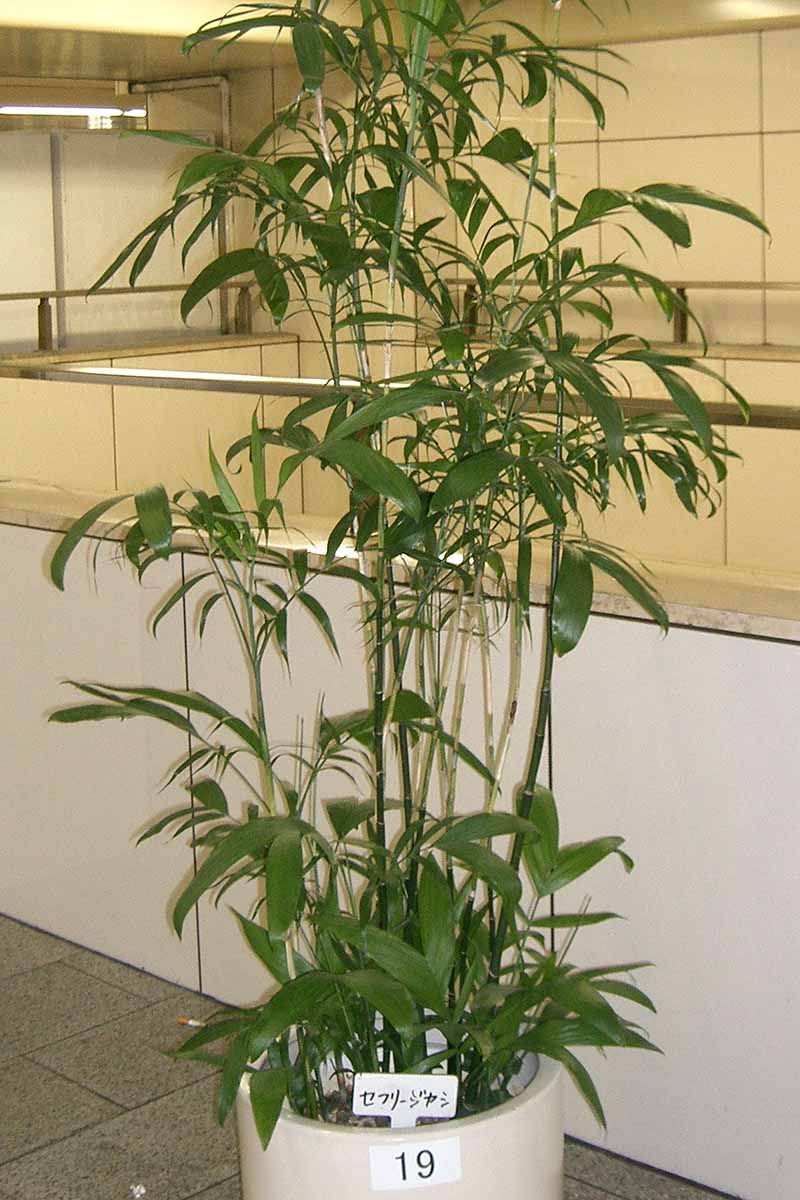
For outdoor transplants in USDA Zones 10 to 11, transplant in spring or fall. For indoor specimens, those can be repotted pretty much whenever you want.
Dig a hole that’s large enough to accommodate the roots of your transplant and deep enough for the crown to be level with the soil line.
Lower the transplant in, backfill with the dug-out soil, then add enough water to fully moisten the soil without turning it soggy.
For in-ground transplants, feel free to add a bit of compost or well-rotted manure to the dug-out soil before backfilling. Bamboo palms love fertile, organically-rich soil.
How to Grow Bamboo Palms
Now that you have a ready-to-go bamboo palm, let’s learn how to keep it going, shall we?
Climate and Exposure Needs
If your bamboo palm is to survive outdoors year-round, you should ensure that you are located in USDA Hardiness Zones 10 to 11.
Indoor specimens, however, can live in an environment that’s kept at a cozy 60 to 70°F.
If you’re trying to save some cheddar on the utilities, then you’ve got some flexibility: up to 80°F is acceptable during warm sunny days, while wintertime temperatures can drop into the 50s without harming the plant.

Regardless of where exactly you’ve set the thermostat, a humid environment of above 55 percent is ideal for bamboo palm houseplants.
To provide this, you can set your specimens on a humidity tray of pebbles that are partially saturated in water, while also keeping them away from dry and drafty parts of the house.
Light-wise, bamboo palms are versatile. Low light to bright, indirect light works for those grown as houseplants, while partial sun to shade works for outdoor specimens. But do your best to prevent bright, direct light and full sun from hitting the fronds.
Soil Needs
The soil you used for transplanting – organically-rich, moisture-retaining, and well-draining, with a pH of 5.5 to 7.0 – will serve a bamboo palm well throughout its life.
Annually amending your outdoor soils with an inch or two of compost in springtime will keep that soil richness topped off nicely.
Water and Fertilizer Needs
Bamboo palms prefer soil that’s kept evenly moist, yet not soggy. To pull this off, water the soil deeply whenever the top inch feels dry to the touch.
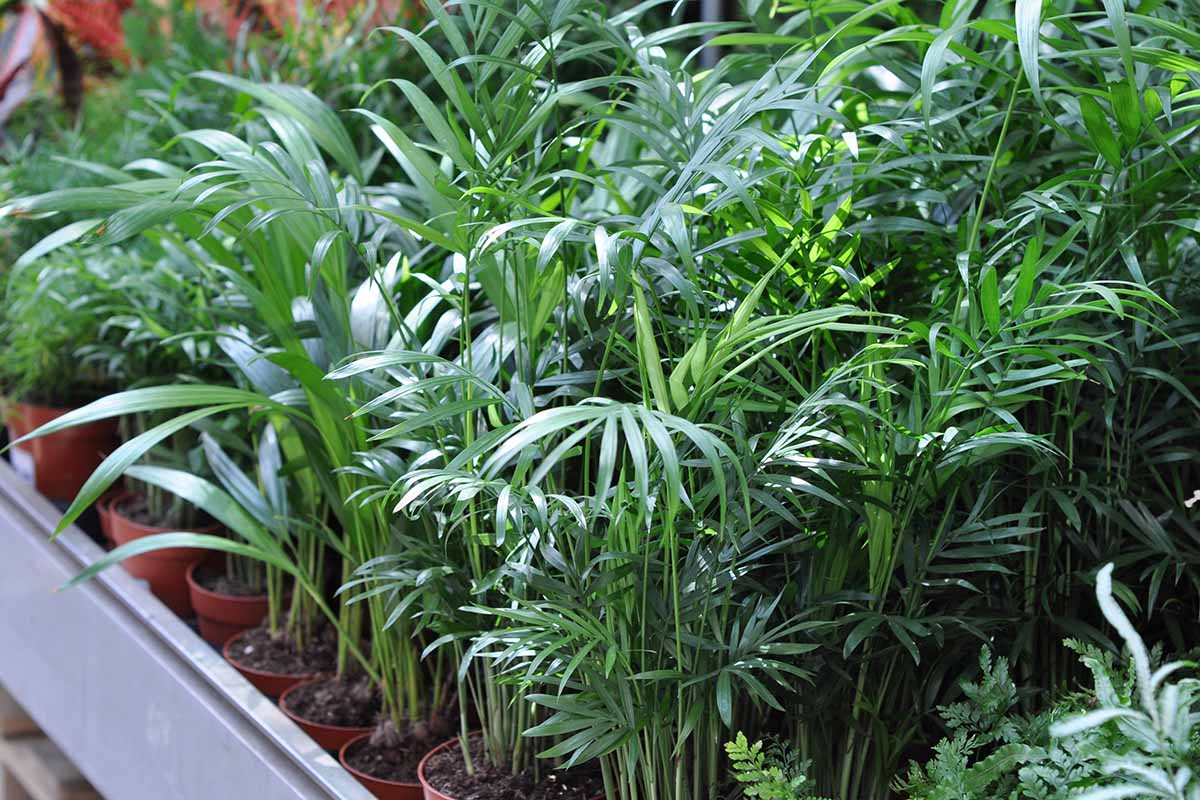
But these plants can do just fine a bit outside of their preferences, though, as they can tolerate dryer soils and even the occasional sogginess.
A balanced fertilizer applied monthly during the growing season should keep your plants well-fed.
Containerized houseplants would do well with Bonide’s liquid 10-10-10 fertilizer that’s available at Walmart.

This water-soluble, powdered 20-20-20 fertilizer from Jack’s Classic via Amazon would be appropriate for in-ground specimens.
Growing Tips
- Be sure to provide your plants with a humidity of over 55 percent.
- Soil-wise, provide both moisture retention and ample drainage.
- Irrigate whenever the top inch of soil feels dry.
Pruning and Maintenance
The bamboo palm is a pretty hands-off plant, which is perfect for all the laissez-faire plant parents out there.
As it grows and develops, the plant is going to outgrow its container, becoming root bound and straining the container’s sides in the process.
Whenever you notice this, either repot it in a larger container or divide it so it can remain in its current size of pot.

If you notice any dry, dead, diseased, damaged, or otherwise unhealthy-looking fronds, feel free to prune them off.
If you have no use for the blooms or their eventual fruits, flower stalks can also be removed as they develop.
During summertime, your C. seifrizii houseplants may benefit from some outdoor time in a partial sun to full shade location.
Make sure you bring your specimen indoors when the temperatures are forecast to drop into the 50s. In the winter months, the bamboo palm won’t require as much water as during the growing season.
Where to Buy Bamboo Palms
“Enough talk! I’m jonesing for some bamboo palms!” Fair enough.
To purchase a plant, start by checking out your local plant nurseries and houseplant shops. If they specialize in tropical flora like C. seifrizii, all the better.
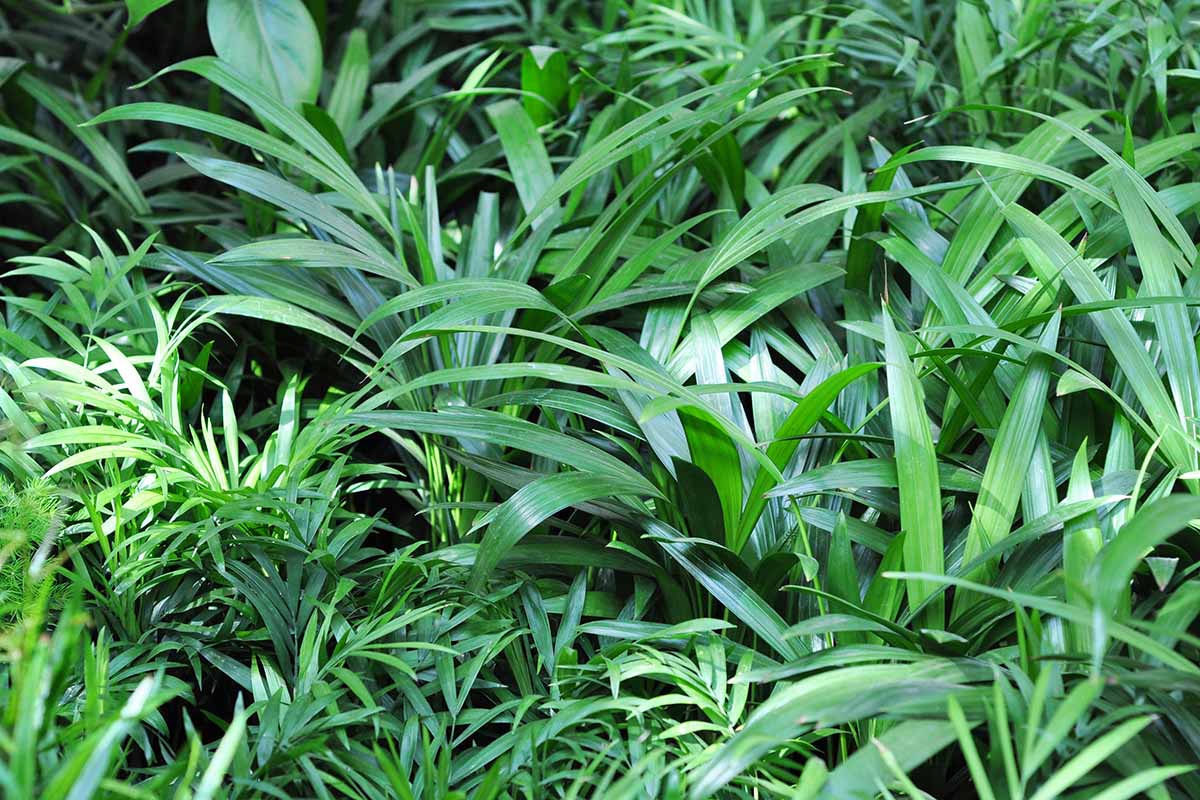
If you have some friends that grow this plant themselves, then it couldn’t hurt to ask them for an offshoot or two. If they have an overcrowded specimen on their hands that needs dividing, then they may even want you to take some.
Dedicated plant swaps and horticultural shows are solid options, too.
Of course, you can always see what is available on the internet. You’ll have to deal with shipping, a waiting period, and not seeing the plant until it’s arrived at your doorstep, but it’s undeniably convenient.
You can find a 10-inch-tall C. seifrizii sold by Costa Farms via Home Depot.
Managing Pests and Disease
Let’s go over some health care tips to keep your bamboo palm happy and healthy.
Insects
Creepy-crawlies can really suck the life out of your plants. They also can vector diseases, so controlling them is definitely a two-for-one!
Mealybugs
Belonging to the Pseudococcidae family, mealybugs are small, oval-shaped, pink-bodied insects that are coated from head to (metaphorical) toe in a mealy white wax, hence the name.

Often congregating in small, protected places on the plant, mealybugs use their piercing-sucking mouthparts to extract vital fluids from the plant, leaving your specimens warped and weakened.
They also excrete honeydew as they feed, which can attract ants and lead to black sooty mold formation.
Infestations can be removed by hand and strong sprays of water, while direct sprays of horticultural oil or insecticidal soap can make quick work of these pests.
Horticultural oil is available from Monterey in both ready-to-use and concentrated forms at Arbico Organics.
Bonide sells their multi-purpose insecticidal soap at Arbico Organics as well.
More mealybug control tips can be found here.
Scale
Members of the Coccoidea superfamily, scale insects live up to their name in appearance.
These round and flattened insects don’t look very threatening, but a clump of them can render a plant chlorotic and stunted with their piercing-sucking mouthparts.
They’re also prone to excreting honeydew, unfortunately.
Control of scale is similar to that of mealybugs, for the most part. You may need to use a fine point like a toothpick for individual insect plucking or a blunt edge like a butter knife for scraping, though.
Find additional tips and techniques for scale management in our guide.
Spider Mites
As arachnids from the Tetranychidae family with eight legs and web-spinning capabilities, spider mites certainly look like spiders. But they require a hand lens to notice, and they’ll feed on your plants rather than hunting actual bugs.
Just like mealybugs and scale, spider mites will suck the contents out of your plant’s cells. The damage starts off as stippled feeding dots, and can progress to chlorotic leaves that eventually drop.
Insecticidal soaps, horticultural oils, and strong sprays of water can all help to control these pests. Be sure to monitor plants regularly for webbing!
For further spider mite know-how, give our guide a read.
Disease
For general pathogen prevention, make sure to use sterilized tools and disease-free growing mediums, as well as remove nearby plant detritus from your outdoor specimens.
Gliocladium Blight
Also known as pink rot, Gliocladium blight is caused by Gliocladium vermoeseni, a nasty little fungus that can do a whole lot of damage to a small palm like C. seifrizii.
This disease is unlikely to trouble plants grown year-round indoors, but those that spend some of the summer months outdoors may be affected.
Accumulating in pink- to salmon-covered masses on plant surfaces, G. vermoeseni spores enter the plant through dead tissues or wounds caused by man, insect, or weather.
Once inside the plant, the fungus causes brown necrosis near stem bases, gummy fluid discharge, chlorosis, necrosis, stem girdling, and eventual plant death.
To prevent this disease, minimize unnecessary plant wounding, avoid water splashing on the foliage, have a solid pest control plan, and be quick to remove dead tissue from plants.
If the disease happens to strike, quarantine your infected plants, remove diseased tissues, and apply fungicides to prevent disease spread. Plants that are too far gone should be promptly removed and destroyed.
Root Rot
Root rot isn’t caused by a pathogen like Gliocladium blight is – it’s entirely abiotic. But it can be just as destructive.
A bamboo palm loves moisture, but not when it’s sitting in standing water. If the soil takes on too much water for a long enough period of time, the roots will fail to receive enough oxygen, effectively suffocating the plant.
As a result, the fronds and stems above the soil line will show signs of decline, from wilting to chlorosis to stunted growth. Eventually, the entire plant could perish.
To prevent this from happening, always make sure to let the top inch of soil dry between waterings.
If your specimen is suffering, you can unpot the plant and trim away any rotted-out roots and a proportionate amount of shoots to help give the plant a fighting chance. If the majority of the roots are rotted, then the specimen’s odds of survival are slim.
Best Uses for Bamboo Palms
A common tropical addition to malls, offices, and other well-trafficked indoor spaces, the bamboo palm is a wonderful, easygoing houseplant for low light spots in the home.
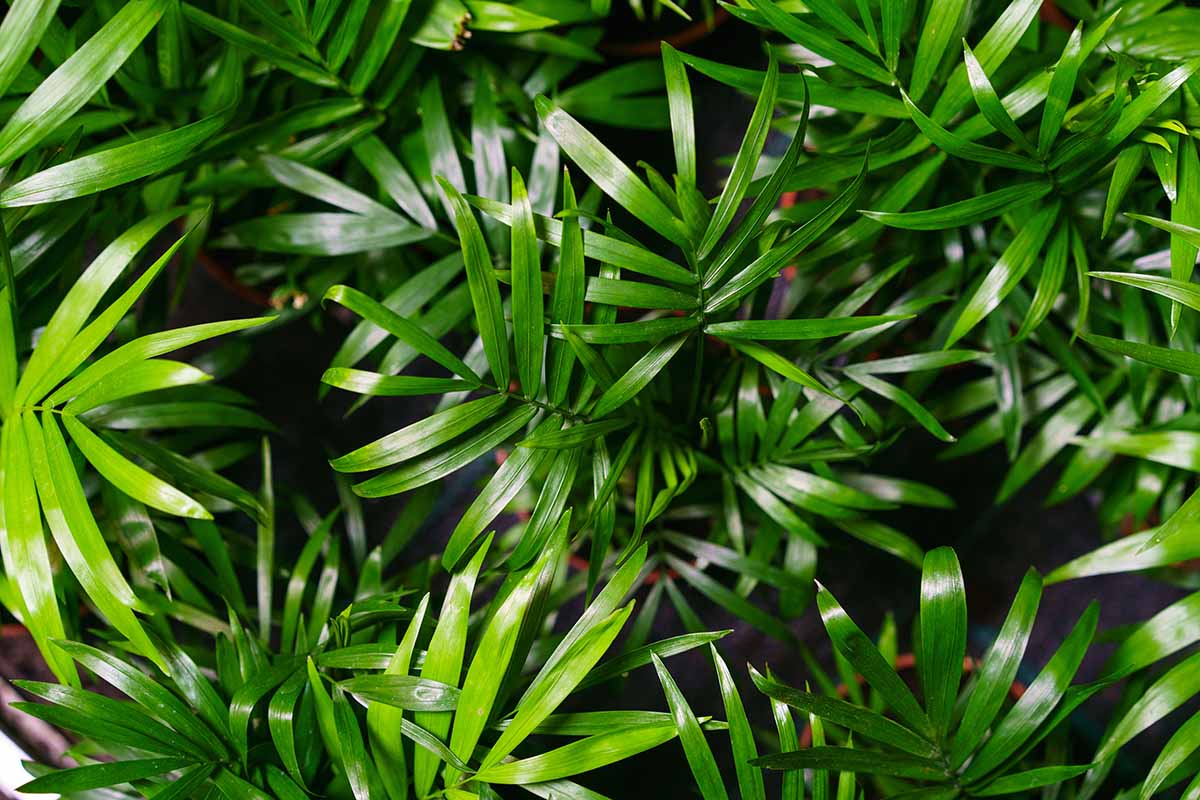
In the outdoor landscape, these plants make fantastic mass plantings, screens, or even backdrops for your more colorful show-stoppers.
Add both a male and a female to your garden, and you may end up with fruits that attract gorgeous birds!
Quick Reference Growing Guide
| Plant Type: | Evergreen flowering palm | Flower/Foliage Color: | Yellow/green |
| Native to: | Belize, Guatemala, Honduras, southeast Mexico | Tolerance: | Heat, humidity, low light, suboptimal moisture |
| Hardiness (USDA Zone): | 10-11 | Maintenance: | Low |
| Exposure: | Bright, indirect light/partial sun to shade | Soil Type: | Rich, moist |
| Spacing: | 1 foot or more (outdoors) | Soil pH: | 5.5-7.0 |
| Time to Maturity: | 10-20 years | Soil Drainage: | Well-draining |
| Planting Depth: | Depth of root system (transplants) | Attracts: | Birds, pollinating insects (outdoors) |
| Height: | 3-10 feet | Uses: | Accent, houseplant, mass planting, screen |
| Spread: | 3-6 feet | Order: | Arecales |
| Growth Rate: | Fast (outdoors), slow (indoors) | Family: | Arecaceae |
| Water Needs: | Moderate | Genus: | Chamaedorea |
| Common Pests and Disease: | Mealybugs, scale, spider mites; gliocladium blight, root rot | Species: | Seifrizii |
For Some Instant Calm, Try a Bamboo Palm
As a bamboo-like palm, C. seifrizii wields the aesthetics of two visually-soothing plants, making it a double dose of tranquility. In this turbulent world of ours, who couldn’t use a little more calm?
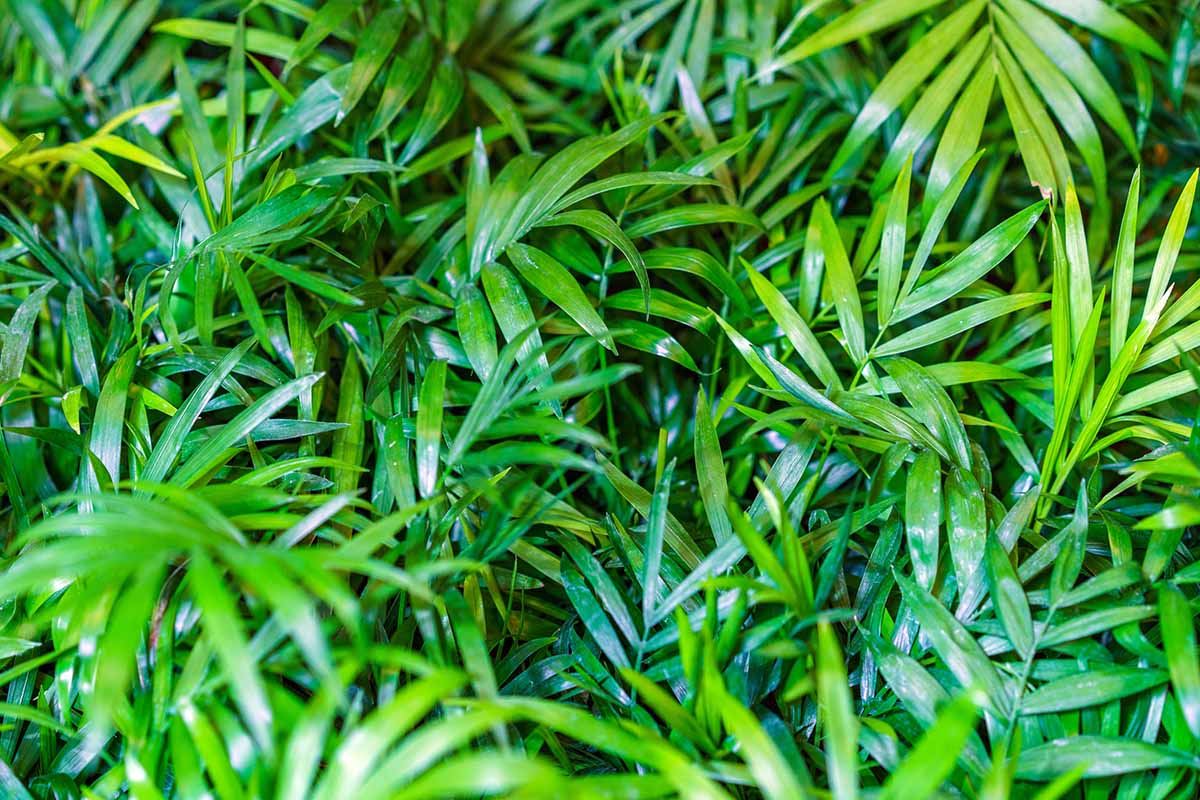
With what you’ve learned in the guide, you’re well-equipped to give these guys all the TLC they need. And in time, you’ll be well-rewarded with vibrant beauty.
Have a burning question or two? Wish there was something I covered, but didn’t? Head on down to the comments section!
And for more information about growing palms as houseplants, these guides should do the trick:

